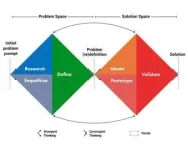Creativity and problem-solving: How design thinking transforms university teaching
2025-04-07
(Press-News.org)
Thinking creatively, solving complex problems, and working in teams… all add up to Design Thinking (DT). A study conducted by the Escuela Superior Politécnica del Litoral (ESPOL) and Ghent University provides a step-by-step guide for teaching this methodology as a university course.
The main objective of this study is to share the implementation of DT in the first year of all undergraduate programs at ESPOL, considering that previous research has shown that this course fosters essential DT skills in a world of constant change, allowing students to build their own knowledge through experiential learning.
In practice, this study offers insights into how to structure and implement an effective Design Thinking course in university settings, providing a model that can be transferred to other institutions. It offers a clear framework for instructors who wish to replicate or adapt this methodology in different educational contexts. From a theoretical perspective, this study contributes to the understanding of how DT aligns with constructivist learning approaches.
Transforming the Classroom into a Real Innovation Space
Since its implementation, the DT course has transformed the way students approach both academic and real-world challenges. Every semester, nearly 1,000 students work in multidisciplinary teams to solve real problems posed by external organizations, such as NGOs, small businesses, and foundations.
In terms of satisfaction, surveys conducted at the end of the course show that over 85% of students reported feeling more motivated to apply DT in other academic and professional contexts. On the other hand, the organizations that collaborated as project sponsors also reported benefits, as they gained fresh ideas and innovative solutions for their challenges.
A Step-by-Step Approach to Developing 21st-Century
ESPOL’s Design Thinking course demonstrates that it is possible to teach complex skills in a structured and effective way. Its success lies in combining a hands-on approach, working with real problems, and using a student-centered methodology. This model can serve as inspiration for other educational institutions looking to prepare their students for 21st-century challenges.
The course follows the six-phase Design Thinking process:
Research: Students collect relevant information to understand the context of a problem.
Empathize: They learn to put themselves in the users' shoes, understanding their needs and emotions to gain insights.
Define: They reformulate the problem based on their previous findings.
Ideate: They generate creative ideas for possible solutions.
Prototype: They build prototypes to make their ideas tangible.
Validate: They test their prototypes with real users and adjust their proposals based on feedback.
The practical, student-centered approach ensures that students not only acquire theoretical knowledge but also develop key transversal competencies for their professional future. The impact of this approach has already been demonstrated in previous research, making it a key driver of 21st-century education.
END
ELSE PRESS RELEASES FROM THIS DATE:
2025-04-07
The American College of Cardiology is recognizing the 2025 winners of its Young Investigator Awards, which took place at the ACC’s Annual Scientific Session (ACC.25) in Chicago.
The Young Investigator Awards competition invites promising, young scientific investigators to present their cutting-edge research. The finalists competed in three categories: Basic and Translational Science, Clinical Investigations and Outcomes Research. This year’s awardees are:
Young Investigator Awards in Basic ...
2025-04-07
Embargoed for release until 5:00 p.m. ET on Monday 7 April 2025
Follow @Annalsofim on X, Facebook, Instagram, threads, and Linkedin
Below please find summaries of new articles that will be published in the next issue of Annals of Internal Medicine. The summaries are not intended to substitute for the full articles as a source of information. This information is under strict embargo and by taking it into possession, media representatives are committing to the ...
2025-04-07
Columbus, OH; Cleveland, OH, April 7, 2025 – CAS, a division of the American Chemical Society specializing in scientific content and knowledge management, and Cleveland Clinic, an academic health system with a global footprint, announced plans for a strategic collaboration that will unite the organizations’ unique expertise, technology, and data capabilities to fuel clinical research.
During the Cleveland Discovery & Innovation Forum, an event highlighting cutting-edge healthcare and life sciences research, the two global organizations announced that their collaboration’s ...
2025-04-07
The Food and Drug Administration (FDA) collects user fees from drug and medical device companies to fund its work ensuring the safety of these products. Creating a similar program that collects fees from food companies could generate much-needed resources to strengthen the FDA’s oversight of foods, according to a new legal and policy analysis published in the journal Health Affairs.
“The FDA is persistently understaffed and underfunded, hampering its ability to ensure the safety of our country’s food supply,” said Jennifer Pomeranz, associate professor of public health policy and management at NYU ...
2025-04-07
While Food is Medicine programs are successfully helping patients manage their health, many initiatives are small-scale pilots, providing treatment to several hundred or several thousand patients. Results of these studies have demonstrated that these nutrition-based food prescription programs improve a range of health outcomes for patients with diet-sensitive conditions, while also potentially saving in medical costs, suggesting wider implementation and investment would lead to long-term savings and a healthier population.
To ...
2025-04-07
Sarah Sjöström, MSN, RN, ACNP-BC, has been promoted to chief nursing officer at Hebrew SeniorLife.
Sjöström joined Hebrew SeniorLife in 2010 as a staff nurse, later became director of nursing in the Medical Acute Care Unit, was promoted to associate chief nursing officer in 2017, and gained the vice president of ancillary services responsibilities in 2023.
She is co-chair of Hebrew SeniorLife’s Age-Friendly Committee and, through that work and as associate chief nursing officer, has championed quality of care and age-friendly practices across the organization. In 2021, she received a John A. Hartford Foundation scholarship to participate in the ...
2025-04-07
When are you most forthcoming with life updates? And when are you the most transparent about exactly what those updates are? For most folks — show of hands, please — it’s when things are going well. Sharing our wins is in our nature; our losses, typically, not so much.
Not surprisingly, governments are similarly inclined. Yet, it turns out, broad government transparency not only breeds goodwill, begetting still more transparency — it can change lives for the better.
Researchers Sarah Anderson and Mark Buntaine, of UC Santa Barbara’s Bren School of Environmental Science & Management, and colleagues ...
2025-04-07
Airborne dust pollution is a growing problem for residente of Utah and other Western states, especially with the exposed lakebed of Great Salt Lake potentially becoming more hazardous as the lake dries. Natural dust blows from the Great Basin and settles along the western edge of the Wasatch Front, Utah’s major population center, and the surrounding mountains. While airborne, the dust mixes with local human-made materials, potentially contaminating the nearby watershed and resulting in other negative consequences, according ...
2025-04-07
Stephen Hauser Wins Breakthrough Prize for Role in Redefining MS
UCSF luminary played a pivotal part in identifying cause of multiple sclerosis, leading to a new generation of game-changing therapies.
Neuro-immunologist Stephen Hauser, MD, whose maverick thinking transformed the treatment landscape for patients with multiple sclerosis (MS), has received the 2025 Breakthrough Prize in Life Sciences.
Hauser, a UCSF professor of neurology and director of the Weill Institute for Neurosciences, was recognized April 5 for overturning ...
2025-04-07
Mass General Brigham investigators have linked difficult early life experiences with reduced quality and quantity of the white matter communication highways throughout the adolescent brain. This reduced connectivity is also associated with lower performance on cognitive tasks. However, certain social resiliency factors like neighborhood cohesion and positive parenting may have a protective effect. Results are published in Proceedings of the National Academy of Sciences (PNAS).
White matter are the communication highways that allow the brain networks to carry out the necessary functions for cognition and behavior. ...
LAST 30 PRESS RELEASES:
[Press-News.org] Creativity and problem-solving: How design thinking transforms university teaching




